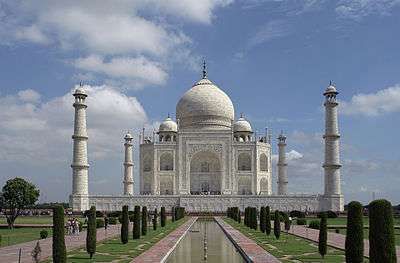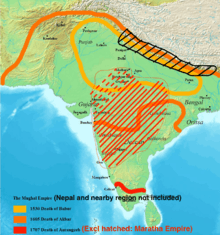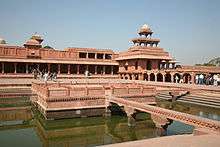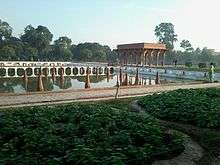Mughal Empire
The Mughal Empire (or Moghul Empire) ruled much of South Asia from the 1520s to the early 1700s. After that it declined drastically, though remnants survived until 1857.

The Mughals were great builders; many of India's and Pakistan's most famous buildings were built under their rule. They also had a tremendous influence on many other aspects of culture.
Perhaps most importantly, the Mughals were largely responsible for the spread of Islam in the region. They were Muslims that reigned over an (at the time) largely Hindu population. Their reign was not free of religious tension but, compared especially to the contemporaneous Christian Spanish Empire, it was also remarkably tolerant of other religions. To this day the presence of Islam in the countries that were once part of that empire is mostly due to the reign of the Mughal Empire.
Origins and rise

- See also: Mongol Empire
The Empire was established by Babur, a Persian-speaking Muslim whose ancestors included Genghis Khan; the term Mughal is derived from Mongol. Timur, known in the West as Tamerlane, was a later ancestor and another great Central Asian conqueror. Mughal is the usual term in western accounts of the period and is common in modern Indian or Pakistani writing, but the rulers called themselves the Timurid Dynasty.
Babur's father ruled the Ferghana Valley region on the Silk Road, near Timur's capital, Samarkand. The family and their subordinates had both Mongol and Turkic ancestors, but culturally they were Persian; their homeland was on the northern edge of the old Persian Empire. The son led an army from there through Bactria, over the Salang Pass to Afghanistan, then through the Khyber Pass into the subcontinent. He went on to conquer much of what are now Pakistan and northern India and to establish his capital at Agra.
The empire is usually dated from Babur's victory at Panipat in 1526. The light orange line on the map shows its extent at Babur's death in 1530. His successors expanded it greatly, as shown by other lines on the map.
The peak
The golden age of the Mughals extended through 150 years and the reign of four emperors, from Akbar taking the throne in 1556 to the death of Aurangzeb in 1707. In this period the empire expanded and the arts and sciences flourished; in particular, many great buildings were constructed.

Akbar ruled 1556-1605 and expanded the empire to include most of northern India, all of what is now Pakistan, and parts of Afghanistan, as shown by the medium-orange line on the map. He built a new capital, Fatehpur Sikri, near Agra and ruled from there for a few years, then moved the capital to Lahore in what is now Pakistan, and later back to Agra. Today both the entire royal city of Fatepur Sikri and the Lahore Fort are UNESCO World Heritage Sites, among the finest examples of Mughal architecture.
Jahangir ruled 1605-1627. He lost Kandahar to the Persians but expanded the Mughal Empire within the subcontinent.
Shah Jahan ruled 1627-1658 and Mughal art and architecture reached their peak during his reign.
Aurangzeb ruled 1658-1707 and expanded the empire to its greatest extent, shown by the heavy red line on the map.
Decline
The empire reached its largest extent, shown by the heavy red line on the map, at the end of Aurangzeb's reign in 1707. From then on it was nearly all downhill.
Persian invaders sacked Delhi, the Mughal capital, in 1736. The Hindu Maratha Empire defeated the Mughals in several battles, and by 1750 the Marathas controlled much of the subcontinent. After the battle of Plassey in 1757, the British took Bengal and for the next hundred years they expanded their territory and influence greatly at the expense of both Mughals and Marathas.
By the mid-1800s there was still a Mughal Emperor, but not much of an empire. The definitive end of the dynasty came just after the establishment of the British Raj in 1858. The last Mughal Emperor had supported the rebels in the Indian mutiny of 1857, so the British convicted him of treason, seized his lands, and exiled him to Burma. Even after that, though, various Mughal-related Muslim rulers such as the Nizam of Hyderabad remained quite important.
Mughal architecture

The most famous piece of Mughal architecture is the Taj Mahal in Agra. Itmad-Ud-Daulah's Tomb, often considered the precursor to the Taj, had been previously erected in Agra at the behest of Nur Jahan, Itmad-Ud-Daulah's daughter and the wife of Jahangir. The existing Agra Fort was also built by the Mughals, on the site of a preexisting fort. The upper, royal part of the city of Fatehpur-Sikri, not far from Agra and covered in the Agra guide, was built at the command of Akbar Khan.
The Red Fort in Delhi was constructed on the command of Shah Jahan and served as the residence of several Mughal emperors. The Jama Masjid was also built at the behest of Shah Jahan. Humayun's Tomb was ordered by his widow, Bega Begum, during the reign of Akbar Khan.
Lahore's walled inner core features the then-largest-in-the-world Badshahi Mosque, built by Aurangzeb. Also in Lahore is the Chauburji Gate at Chauburji Chowk, and many tombs and mausoleums, such as those of Jahangir and Nur Jahan in the suburb of Shahdara. The celebrated Shalimar Gardens, a three-tiered formal garden, were built in the 1600s and are a UNESCO World Heritage Site.
Aurangzeb also commissioned the Bibi Ka Maqbara, a monumental tomb for his wife, Dilras Banu Begum, in the city of Aurangabad, which is named after him.
Like Lahore's Shalimar Gardens, the Shalimar Bagh near Srinagar is also in three terraces and was built in the 17th century.
The Pinjore Gardens, near Chandigarh, are also impressive. They date from the reign of Aurangzeb.
Also built during Aurangzeb's reign was the Lalbagh Fort in Dhaka, Bangladesh, which though never completed is still impressive.